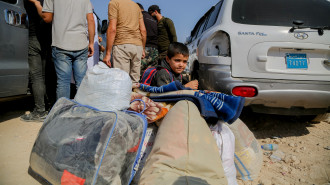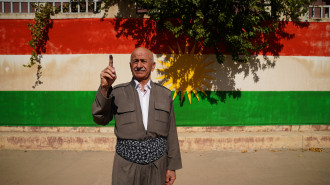The sectarianization of Syria and smearing a revolution
As the brief lull in Russian bombing comes to an end, Aleppo is entering its biggest and perhaps its last battle. For most people in the liberated east of the city, this is a battle of survival against a genocidal regime, and a battle for democracy too, because in their hard-won liberty they have built democratic councils and a free media.
Yet to the outside world, Aleppo often looks like a battle between sects - and with good reason. A small proportion of the city's defenders are Sunni jihadis with previous links to al-Qaeda. On the Assad regime's side, up to 80 percent of its fighters are foreign Shia jihadis organised, trained and funded by Iran.
Turning the tide
It didn't have to be this way. The year 2011 marked a turning point in the collective consciousness of Syrian society. In a country divided by sect, ethnicity, region and class, a protest movement for freedom, dignity and social justice united people from a wide range of backgrounds. Suddenly the term "Syrian people" gained a new, practical significance and became much more than a state-directed slogan.
Men and women took to the streets calling for the downfall of the four-decade dictatorship. As the "fear barrier" famously broke, Syrians discovered themselves, each other, and their country anew. Few, for instance, had previously heard of the small town of Kafrnabel, in the rural north. But the witty banners activists in the town produced every Friday for its demonstrations brought it to national attention.
 |
The first task of the counter-revolution - practicing age old tactics of divide and rule - was to destroy this developing organic unity. |  |
Revolutionaries chanted in solidarity with towns resisting the regime's brutal crackdown - "Oh Homs (or Deraa, or Hama) we are with you until death". Slogans such as "One, One, One, the Syrian People are One" called for national unity and were against sectarianism. Groups such as "Nabd" ("Pulse") were established to promote diversity and coexistence.
Young Kurdish and Arab activists established the Kurdish-Arab Fraternity Coordination Committee, which launched campaigns such as "Khorzi, I am your brother - Arabs and Kurds are one". Well-known Alawites (from the sect to which President Bashar al-Assad belongs) lent their support to the revolutionaries. One was the actress Fadwa Suleiman, who led protests in the Sunni-majority city of Homs.
The first task of the counter-revolution - practicing age old tactics of divide and rule - was to destroy this developing organic unity. One of the early methods the regime employed was the unequal distribution of violence in its response to the uprising. Areas which were wealthier or had a higher proportion of minorities were treated more gently; teargas instead of bullets was used on protesters. The regime withdrew from Kurdish majority areas without a fight, handing over security installations to the Kurdish Democratic Union Party (PYD).
Working class Sunni-majority towns and suburbs, on the other hand, were barrel-bombed and gassed. This helped form cleavages between Arab and Kurdish revolutionaries, and between Sunnis and religious minorities.
Paint it black
The non-sectarian democracy movement was portrayed by the regime as an extremist "Salafi-Jihadist" plot from the outset, with the hope of frightening minorities into loyalty. This began with false flag operations, described in detail by Alawite writer Samar Yazbek in her wonderful book A Woman in the Crossfire: Diaries of the Syrian Revolution. Regime thugs known as Shabiha instrumentalised sectarian hatred by carrying out violent acts in the coastal cities of Banyas, Jebleh and Latakia, spreading rumours amongst each sect that the other was responsible. Then came a spate of sectarian massacres.
The Syrian Network for Human Rights documented 56 sectarian massacres between March 2011 and June 2015. Of these, 49 were carried out by regime forces (both local and foreign militias) and included sexual crimes, the burning of homes, and the slaughter of entire families. According to the network, no other group resorted to ethnic or sectarian massacres until June 2013. The purpose was to incite other groups to revenge - and it worked.
 |
As the regime rounded up civil activists and protesters en-masse for indefinite detention - and often death by torture - it released 1,500 Salafi prisoners in 2011. |  |
The second target of these provocations was the international community. The regime couldn't win support for a crackdown on peaceful protesters, but it could win support for a "War on Terror". As the regime rounded up civil activists and protesters en-masse for indefinite detention - and often death by torture - it released 1,500 Salafi prisoners in 2011. The beneficiaries of the amnesty included Abu Muhammed al-Jolani, who went on to lead al-Qaeda's ex-affiliate Jabhat al-Nusra. There was also Hassan Aboud, who led Ahrar al-Sham, and Zahran Alloush, who led Jaish al-Islam until his death in an airstrike.
Collusion
For many months after the arrival of the Islamic State group on the scene, the regime in effect pursued an undeclared non-aggression pact with the group. IS is a great excuse for the continuation of violence perpetrated by the regime and its supporters. Russia claimed its intervention was directed against the terror group, but over 80 percent of its bombs have fallen nowhere near IS-controlled areas. Iran tells its people that its presence in Syria is to defend them from "Sunni-jihadism".
Yet most Iranian-backed forces are fighting rebel groups that are defending democratically-organised communities, including the Free Syrian Army militias. The presence of Iran's Shia-jihadi militants greatly assists the Sunni-jihadi narrative.
When the town of Daraya - close to the capital - fell to the regime in August, its residents (both civilians and fighters) were cleansed and sent to rebel-controlled Idlib far to the north. Iraqi Shia families were then moved into vacant homes. Reports have also emerged of Iran buying property and real estate in Homs and around the capital Damascus, after local inhabitants were forcibly expelled from their homes following heavy bombardment, massacres or starvation sieges in an attempt to change Syria's demographics.
In a speech in July 2015, Assad declared, "Syria is not for those who hold its passport or reside in it, Syria is for those who defend it".
In a remarkable echo of this sentiment, IS' leader Abu Bakr al-Baghdadi said: "Syria is not for Syrians and Iraq is not for Iraqis. The land is for the Muslims, all Muslims." In areas controlled by IS, religious minorities have been driven out, murdered, forcibly converted, or enslaved - even those Sunni Muslims who dare to dissent from Baghdadi’s perverse definition of Islam.
Some commentators hold that this process of ethnic-sectarian soft partition was an historical inevitability. Close attention to realities on the ground proves otherwise. In 2011, revolutionary Syrians expressed their desire for social unity, tolerance and diversity in order to achieve their dream of a free and democratic Syria. Many still do. It took the sustained violence of the forces of counter-revolution, backed by the full weight of foreign military intervention, to smash this possibility.
Leila Al-Shami is a British-Syrian activist who has worked with the human rights movement in Syria and elsewhere in the Middle East. She is co-author of Burning Country: Syrians in Revolution and War

![Palestinians mourned the victims of an Israeli strike on Deir al-Balah [Getty]](/sites/default/files/styles/image_684x385/public/2024-11/GettyImages-2182362043.jpg?h=199d8c1f&itok=xSHZFbmc)


![The law could be enforced against teachers without prior notice [Getty]](/sites/default/files/styles/image_684x385/public/2178740715.jpeg?h=a5f2f23a&itok=hnqrCS4x)
 Follow the Middle East's top stories in English at The New Arab on Google News
Follow the Middle East's top stories in English at The New Arab on Google News


